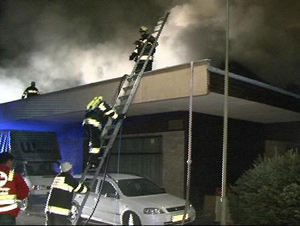Subtitle: The Apprentice System is Not Extinct
 Last August, I wrote about a tragic oily rags incident where two elderly people lost their lives. I come back to it now because a trial has been held and has a finding of “neglect.” To us woodworkers, that was obvious from early reporting.
Last August, I wrote about a tragic oily rags incident where two elderly people lost their lives. I come back to it now because a trial has been held and has a finding of “neglect.” To us woodworkers, that was obvious from early reporting.
What makes it interesting is that we’re seeing lots of old woodworking books being republished, some describing the apprenticeship system of centuries past. Well, dear readers, that system is not extinct. It is still being practiced, in some aspects, today.
In this case, a “master” joiner had left an “apprentice” to apply some oil finish to work in progress and then close up the shop. The master then went to visit another customer. The master testified that he gave complete directions to the apprentice about materials disposal, and warned him of the possibility of combustion. There seems to be some dispute on this point, according to recent news. (hint: use Google translate if you don’t read German.) The apprentice disposed of most materials properly, but swept up a few rags and put them in a dustbin inside the shop. The resulting fire quickly engulfed the shop and the living quarters above where two people failed to get out.
I found it interesting that part of the defense was the point that current teaching about the danger of materials is in the third year. This was a first year apprentice who was apparently using materials without understanding their danger.
It’s not my purpose to determine any sort of blame, but to spread these cautions so you don’t have to wait for the third year of your apprenticeship to learn them.
Please dispose of oily rags properly.
- Submerge them in water until you have time to collect them all, wring them out, and BURN them.
- OR, spread them out flat, in a non-combustable area outdoors, and let them dry completely before adding them to the refuse for pickup.
Good advice, Bob. It’s hard to know why it is so hard for folks to follow. Perhaps a real demonstration of rags in combustion is necessary.It probably wouldn’t take long.
One woodworking associate I know worked in a shop on Long Island where someone left a couple oily rags in the middle of a bench. They caught fire and burned so intensely that they created a hole straight down for two floors!
I know that oily rags can generate heat and combust, but I have never understood the science behind it. What is really going on to make this happen?
And yes, a demonstration done outdoors on a quiet day would be pretty neat.
It is my understanding that chemicals are added to the oil to accelerate an otherwise slow curing (polymerization) process. As this reaction proceeds, heat is generated, and in the case of bunched up rags soaked with this modified oil, the heat eventually causes the rags to ignite. Natural oils devoid of any chemical modifiers are generally non-toxic and do not start such fires, but they also do not cure and harden in a timely manner. I am an organic chemist by training, but I may not have the complete story. The bottom line is that this threat seems to result from the desirable qualities associated with fast curing oil finishes.
The science is the following…
First a definition: Spontaneous combustion is defined as occurring when the temperature of certain materials increases, without drawing heat from the surroundings, until the ignition temperature of the material is reached and hence ignition occurs.
Many “drying oils” oxidize quickly. (As Steve mentions above, this is sometimes due to driers added to the oils. Yet, it also happens with a few natural oils such as Linseed and Tung [real tung, not the varnish stuff].) When oxidizing, the oils produce heat. A bunch of oily rags tightly clumped together does not expose much surface to oxidation, so heat build up is too slow to cause ignition. A single oily rag hanging on a clothes line, or spread flat on the ground, has enough air circulation around it to dissipate the heat it generates. The real danger is from a bunch of loosely clustered oily rags, especially in a space with little air flow. They have lots of surface film generating heat and too little air flow to carry the heat away. Before long, “poof.”
This PDF document has a good description.
A YouTube video here shows the end of the process. I haven’t yet found a video of the complete process, which is quite long. The document above described a controlled test where a bunch of rags were placed in a trash can. It took about an hour for smoke to begin, but over 4 hours for actual flames to appear.
Thanks for the explanations. That makes sense and, hopefully, will help keep us all mindful of the dangers.
That is just amazing. To think that oil drying out in rags can produce smoke in an hour is incredible. That’s a lot of heat! Thanks for posting this, it’s very informative, and I’m glad to know the details.